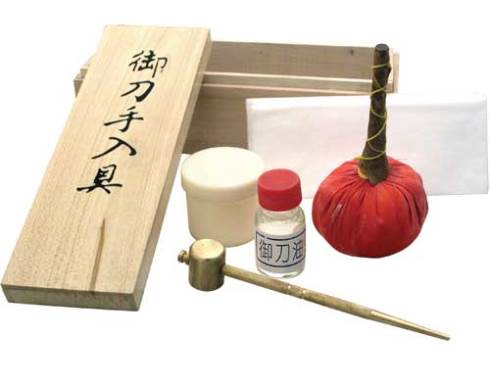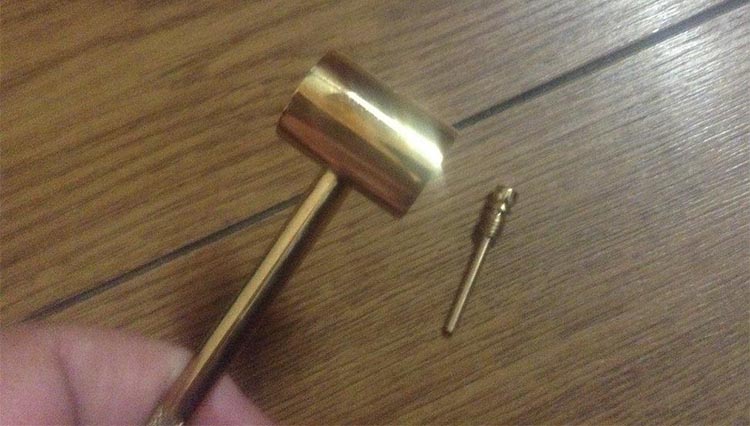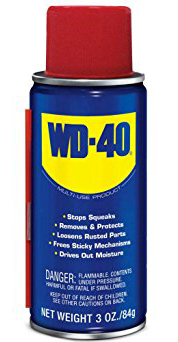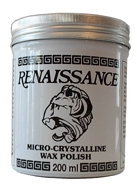Can I Use Baby Oil to Clean My Sword
- Home
- Ultimate Katana Buyers Guide
- Total Newbies Guide
- Katana Maintenance
Katana Maintenance 101
Katana maintenance tin be a very intimidating thing for a beginning sword collector. After all, every bit all functional swords are made from carbon steels that are prone to rust, its easy to worry that if you exercise it wrong, next time you draw your Katana from its sheathe you will see those dreaded black or red spots of doom..
Luckily, it's actually really simple to keep your Katana in tip top shape.
Those (ofttimes useless) 'cleaning kits'

You have all seen them, that collection of mysterious looking objects in a balsa wood box - sometimes they are even included as 'freebies'..
But even if they are free (which they aren't actually, the toll of the kit is congenital into the price) well-nigh are basically only gimmicks.
Here is a listing of what you will typically notice inside ane:
- A small contumely hammer used to take the mekugi pegs out. Simply trouble is, most are not threaded well and cannot actually be used for the purpose.
- A canteen of choji oil (oftentimes empty, due to hazardous textile shipping regulations).
- An uchiko powder brawl. Traditionally filled with powdered whetstone, nearly are just filled with talcum pulverisation and pretty useless.
- And some rice paper to put the oil on and a affair to shop it in to protect from the air drying it out.
All in all, most of the materials in there aren't original and are not actually very usable - and nosotros offer some suggestions on how to brand your own kits here.
More expensive kits do contain components that ARE functional. The all-time ones I have seen were from Nippon costing around $fifty in a leather case.
 The mekugi-nuki from a high end Japanese cleaning kit. This one IS actually functional, only hardly necessary.
The mekugi-nuki from a high end Japanese cleaning kit. This one IS actually functional, only hardly necessary.
If you are curious as to how they are used traditionally, the short video beneath shows you basic Katana maintenance as done in Japan.
But all in all, it is unnecessary for basic Katana maintenance:
- To remove the menuki, a blunted smash and small hammer works better than any specialized mekugi-nuki hammer.
- You can make your own choji oil - but we will get to oils in more particular in a moment.
- The Uchiko powder brawl can be replaced past actual talcum pulverization (used to soak up excess oil earlier wiping the blade clean and dry).
- And rice newspaper, easily changed out for a clean, lint gratuitous white fabric.
So now that we know what is not of import for Katana maintenance, allow the states take a look at what IS important..
What yous Actually need for premium Katana maintenance

We listed the substitutions for Katana maintenance kit components, only in all honesty, in that location are basically merely ii things you need to practice to keep your sword in tip summit status..
- The blade should be coated in a thin protective layer at all times when not in use.
- After cutting, the sword needs to be quickly cleaned to avoid staining.
The kickoff betoken is pretty simple - all y'all need to practice is detect a readily available oil yous tin apply with a textile to the sword to coat information technology in a fine sheen. Choji oil is traditional and has a pleasant scent to information technology - only personally I tend to use 3 in ane oil, Vocalizer Car oil, mineral oil or even WD-40 in a compression..(the only problem with using WD40 for long term Katana maintenance is that it tends to dry out quickly).
As steel is steel regardless of its shape or style, the bones sword care principles explained on our site here apply.
The 2d point is in the camp of 'prevention is improve than cure'. Cutting any target that has some moisture (rolled soaked tatami mats, water filled bottles, bamboo, fruit, vegetables, etc) will stain the blade in a matter of minutes and tin can be stubborn to remove if left alone too long.
This is especially true of fruits and vegetables every bit they have acids that can wreak havoc on the finish of the bract.
Luckily, its easy to preclude - just keep a clean, slightly damp material and some WD40 or rubbing alcohol handy and give the blade a wipe down and/or a quick spray to forbid whatsoever nasty stains from forming.
After cutting,information technology is a good idea to put the blade nether running water for a white (indicate facing downwardly so that it runs off the tip) and spray with WD40 before re-oiling as usual.
Things to Avoid and some additional tips
In a nutshell, Katana maintenance IS as easy as ensuring the blade has a fine protective blanket to protect it from rust. If yous tin easily come across the oil, its likewise much - and volition possibly damage the inside of the saya. Less is more, all you need is enough to protect from humidity.
While there are a ton of oils that can be used to protect a sword - they all have one affair in common: no organic material. In other words, no cooking oil, baby oil, etc.
Naturally, the first thing you want to avoid happening is that oil drying out unexpectedly - but how chop-chop it will dry out depends on your climate, so the general rule of thumb is to sentinel out for hot or humid conditions and audit the oil regularly until you get a sense for how oftentimes you need to perform oiling and basic Katana maintenance for your geographical location (as a rule of thumb, once every ane-3 months is pretty typical).

Displaying the exposed bract can exist problematic as grit particles will soak up some of the oil, creating patches of rust. For long term protection and for protection of swords, the British museum uses Renaissance Wax - a micro-crystalline wax polish ideal for long term solutions.
Finally, be mindful of what you cutting - as stated earlier, fruits, vegetables and organic materials can easily stain a bract if the acids are left to soak into the steel and can be a bear to clean once established - so again with Katana maintenance as with anything else, prevention is better than cure.
Similarly, some targets can be more damaging to a blade than you might recollect. For example, paper-thin typically has tiny bits of ground up glass an other impurities from the recycling procedure in information technology that can actually scratch up a blade.
Withal, if your all-time efforts at Katana maintenance fail and yous need to have measures not to maintain but restore your sword, you can observe a wealth of information on how to do this on our sword care page appropriately.
I hope this information on Katana maintenance has been helpful. To return to Basic Sword Intendance and Maintenance 101 from Katana Maintenance 101, click here

Ownership Swords Online Can Be DANGEROUS!
Find the All-time Swords in the:
Popular & Recommended ARTICLES

mcallisterowareasti.blogspot.com
Source: https://www.sword-buyers-guide.com/katana-maintenance.html
0 Response to "Can I Use Baby Oil to Clean My Sword"
Post a Comment